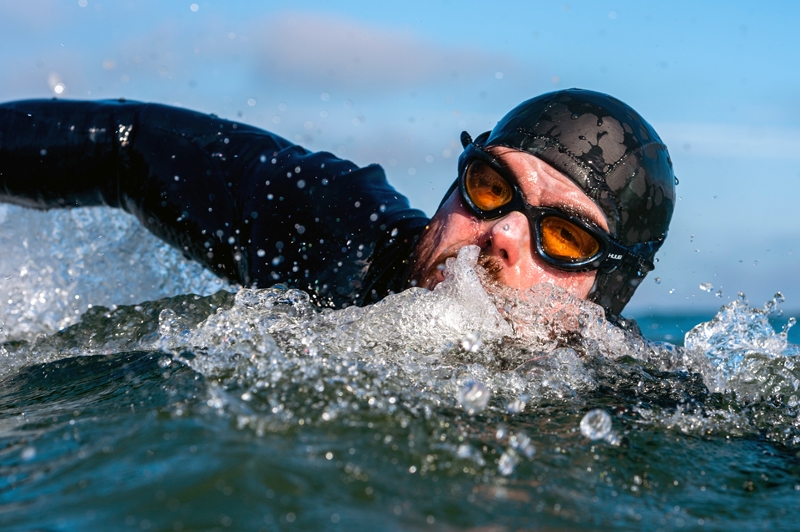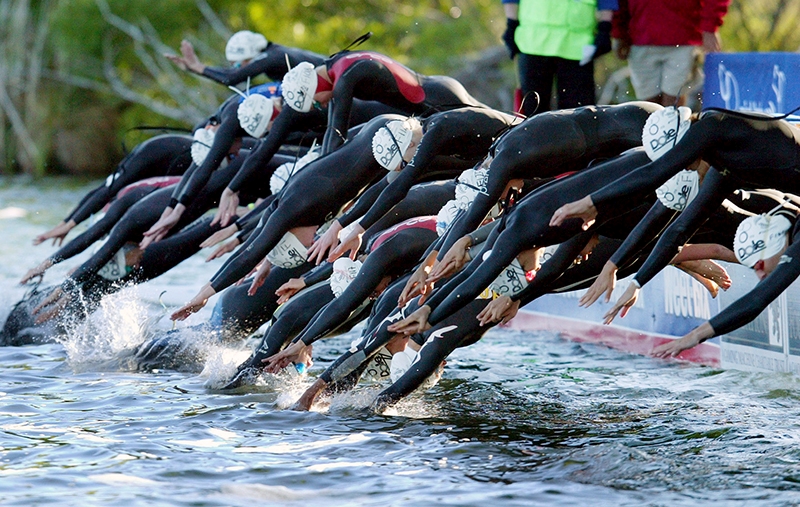You are viewing 1 of your 1 free articles. For unlimited access take a risk-free trial
High and dry? Why swimmers should head for open water

Andrew Hamilton looks at the science of open-water swimming, and explains how swimmers of all backgrounds could benefit –especially now that most swimming pools are closed due to the current lockdown restrictions
On the face of it, swimming as a sport is not exactly associated with the great outdoors. This is hardly surprising really. For starters, for those living more than 40 degrees north or south of the equator, open waters are rarely inviting. Even in northwest Europe, which is bathed in the temperate waters of the Gulf Stream, a mean sea temperature of around 12 degrees C is still chilly enough to bring tears to the eyes of even the hardiest souls(1)! Then there’s the issue of finding some suitable open water in which to train.However, no matter how warm, cozy and conveniently located the local pool is, many swimmers are currently marooned on dry land because in large parts of the world, all leisure facilities – including swimming pools – are closed due to movement restrictions. And while cross-training and dry-land strength training can help to keep fitness levels up, many swimmers are missing out on the fitness and skill-specific action of actually swimming. But for those who live near a body of water such as the sea, a lake, or river, there could be another option – open water swimming.
What is it?
At the risk of stating the obvious, open water swimming takes place almost anywhere other than a pool. Apart from the sea, lakes, reservoirs and even rivers can provide you with open water swimming opportunities. Although many people assume that open water swimming necessarily entails swimming huge distances as exemplified in that first famous swim by Captain Matthew Webb, the first man to cross the English Channel back in 1875, the reality is that it’s up to you how long and far you swim.Many swimmers though do end up getting hooked on the open water and turn to competitive racing. However, the real difference between open water swimming and pool swimming is the experience itself. Quite apart from the sense of freedom and the chance to enjoy your surroundings in open water swimming, you can really get into a good stroke rhythm. There are no brick walls every 25 or 50 metres to break your stroke pattern and unless you’re in a race, no bodies on your way. It’s just you and the water below you.
Open water benefits -the science
Open-water swimmers who also compete in the pool frequently comment on the benefits of adding in open-water sessions – and it turns out that these benefits are not just anecdotal. In 2017, a comprehensive review study (a study that pools data from a number of other studies) looked at the evidence for and against performance and fitness benefits of open water swimming(2). The researchers concluded the following:- *Regular open-water swimmers were able to swim at very high percentages (80-90%) of maximum oxygen uptake (VO2max) for sustained periods of time.
- *Good open-water swimmers were able to sustain a high velocity for many hours, which resulted from a high propelling efficiency (efficient stroke technique) and a low energy cost per unit of distance covered.
- *There was a higher overall competitive level among female swimmers than males – this is one sport where the girls have an advantage over the boys!
The unknown
There’s something else that marks out open water swimming. Humans are land creatures who have managed to master our terrestrial environment. But when you swim in the lakes or the sea, you have to leave the cozy world of human control behind and come face to face with the raw elements. It doesn’t matter how strong or how fast you are in the pool, swimming across open water is a whole new ball game. There are a number of things you’ll need to contend with:- #Deep water – there’s no blue line at the bottom of a lake of the sea. Even top open water swimmers can sometimes feel spooked by the thought of tens or even hundreds of feet of deep, inky black water below them while they swim.
- #Cold water – unless you live in the tropics, you’re going to have to deal with this one. The good news is that modern wetsuits have made cold water swimming possible for even the leanest athletes, but it can still come as a shock to feel that water on your face, hands and feet for the those first few minutes of the swim, while you acclimatize.
- #Other objects – was that a bit of seaweed, a fish or something with much bigger jaws that just brushed underneath me? On those inevitable occasions when you do feel find you’re not alone in the water, you need to keep your nerve. Jellyfish are a common nuisance for sea-swimmers, especially when they sting the face and an occasional shark sighting can certainly add excitement to your workout!
- #Waves – when wind blows across water, it produces lumps, more commonly known as waves. Although you may think your pool gets a bit choppy, swimming through real waves is something else. You have to be prepared to modify your stroke and breathing to cope with the rougher stuff. And even if you do, you’ll find the next problem is…..
- #Navigation – this is when you actually begin to miss those blue lines. Getting only occasional glimpses of landmarks or marker buoys makes navigation difficult, especially when viewed from such a low angle. If you’re in the sea you may find that between two waves you see nothing other than walls of water piled up around you. You need to also be aware of the effect of currents, which can throw your navigation off course.
Safety for open-water novices
If you’re new to open water swimming, it makes sense to think about safety before you take the plunge. This is particularly the case if you’re going to be swimming in open water away from an organised or supervised environment, such as a race or a beach patrolled by lifeguards – very likely if you currently have movement restrictions in place. Even if there are others around, don’t go into the water with the attitude that you can depend upon someone else to bail you out. Needless to say, open water swimming is NOT recommended unless you already have good swimming technique in the pool and a high level of fitness as an absolute minimum. If you have any doubts about your ability, competence or confidence you should think twice – it’s just not worth risking your life. Detailed below are some of the factors that need to be borne in mind before entering open water.Cold water - One of the biggest challenges will be the colder water temperature compared to swimming pool water – especially at this time of year in the Northern hemisphere, where seas and lakes have only just begun to warm after the March minimum. Researchers have summarized the physiological changes that occur when swimmers enter cold (below 24C/75F water)(4):
- *Initial immersion (0 to 3 minutes) — the initial period, which is associated with highest risk of fatal outcome; the rapid skin cooling can trigger a “cold shock” response.
- *Short-term immersion (3 to 30 minutes) — the short-term period is associated with neuromuscular cooling.
- *Long-term immersion (30 minutes plus) — the point at which deep core temperature may drop, and hypothermia ensues.
Box 1: When should I swim?
Because water takes longer to heat up and cool down than air, the temperature of large bodies of water such as the sea and lakes tends to lag behind the air temperature. This means that in the Northern Hemisphere, the sea is warmest two months AFTER the summer solstice, around the end of August/ early September and coldest around the end of February/early March. These peaks are of course reversed in the southern hemisphere. There’s also a smaller daily temperature, more noticeable in shallower water, especially on sunny days. Late afternoon is the time to swim if you want the warmest water of the day – first thing in the morning if you like it cool. However you won’t notice this effect in deeper water or in the sea, unless you’re swimming in a shallow bay.EIB - Another potential problem of cold-water swimming is exercise-induced bronchoconstriction (EIB), which has been reported to occur in up to 50% of swimmers(5). While the condition is frequently diagnosed in pool swimmers, swimming in cold environments also is a significant risk factor for EIB producing symptoms such as wheezing, chest tightness, cough, and shortness of breath within several minutes of high exercise intensity.
Environmental considerations – choosing a suitable location for open-water swimming is important. A recent paper published last year outlined the considerations required for swimmers’ health and safety(6):
- #Water quality – swimming in water with high microbial counts is associated with various complaints such as gastrointestinal and ear infections(7). The problem is exacerbated followed heavy rainfall, where run off from agricultural land can occur(8). Before choosing a swimming location, consult your regional environment agency/regulator to see which bodies of water are suitable. In Europe for example, coastline where the sea water meets high standards for bathing is given a ‘blue-flag’ award. In addition, cyanobacterial blooms (blue-green algae) pose a threat to bathers’ health, especially at high concentrations(9).
- #Natural hazards - The presence of rips and currents can impact swimmers of all abilities. Often, rips can travel up to 3mph and weaker swimmers can become rapidly exhausted swimming against the tide(10). Low lying sandbars are problematic, especially close to shore where the waves break leading to ‘dumping’ of the incoming swimmer. This phenomenon also occurs in rivers and lakes, which are particularly prone at times of high rainfall or tidal inflow/outflow. Ideally, you should ensure the water depth is at least 1.5 metres over the whole route of your swim.
- #Wildlife - Swimming in the waters of territorial animals such as sharks, rays, or crocodiles is an obvious concern; however, documented attacks on swimmers are fortunately very rare. Of more concern perhaps is the inadvertent contact with a floating organism in coastal waters such as a jellyfish, which can produce a anything from a mild skin reaction to a nasty sting or worse. Several troublesome species are common in warmer Australian waters over the summer months (eg Australia Irukandji, box jellyfish) and contact with these can result in severe and life-threatening anaphylactic shock. Risks can also occur from inadvertent contact with a dangerous organism upon entering or exiting the water for example, a stonefish or catfish.
Box 2: Practical safety tips for open water swimmers
- -Don’t swim alone – if you can, swim where there are beach lifeguards around or with someone else who is also a competent and proficient open-water swimmer. If you can both life save, so much the better. In cold conditions, even the best swimmers can experience unexpected stitch or cramps.
- -Be visible – wear the brightest swimming cap you can. It’ll not only help others to see you should you get into trouble, but make you more visible to any boats or jet skis in the area.
- -Tell others – if there’s anyone on the shore, tell him or her what your swimming plans are.
- -Obey instructions – if you’re swimming in a patrolled area or in an event, don’t ignore any safety advice. In particular, you need to be aware of any potentially dangerous underwater obstacles such as sharp rocks or old wrecks, and the whereabouts of riptides or strong offshore currents that could throw out your navigation.
- -Seek advice – if you’re swimming in an unfamiliar stretch of water, seek advice about the venue and the best swimming areas, especially any underwater hazards or currents. Check that the water quality is suitable. The last thing you want is to end up with an eye infection or a stomach upset.
- -Never dive in to unfamiliar water – you may get a nasty surprise when the rocks just below the surface smash into your skull.
- -Swim parallel to the shore – assuming there are no hazards (above), always swim parallel to the shore. If you get into trouble, you can more easily get back to safety than if you simply swim out to sea or to the middle of the lake. If you’re doing a point-to-point swim, try to choose two points that will keep you close in to the shore.
- -Food and drink – never swim within 2 hours of a meal. Never swim after even the smallest amount of alcohol.
- -Watch the weather – don’t try and swim in really rough sea conditions, no matter how tough you think you are. Quite apart from entering and leaving the water, where it only takes one wave to pick you up and smash you down on the sea floor, you’ll find it extremely difficult to breath and navigate when the water is very choppy. Never swim in foggy conditions – not only will you lose your bearings when the shore disappears from view, but you will also not be visible to others.
- -Keep warm – cold water takes it toll on the body quickly – make sure you have a wetsuit for cold water and that it’s suited to the conditions (see kit).
Other practical considerations
Stroke and breathing - In totally calm conditions, there’s not much difference in swimming technique between open water and pool workouts. Of course, from time to time you’ll have to hold your head up and snatch a quick look to get your bearings and help you navigate but that’s about it. To begin with, you’ll be tempted to do this every few strokes as you set out into the unknown. But you soon realize that lifting your head wastes a lot of energy by ruining your streamlined position(11), and as your confidence grows, you’ll get used to looking less frequently.Once the water gets choppy, which is almost always, you’ll need to modify your stroke and breathing techniques. The choppier the conditions, the higher you’ll need to lift your arms out of the water in between strokes otherwise you’ll find your arms will get knocked all over the place, which will make the next stroke that much harder to execute. Get the hand out of the water and get it high quickly.
Breathing in choppy water is a real skill and no matter how good you become, you’ll have to be prepared to swallow the odd mouthful of water from time to time. Most swimmers prefer to turn their head to the opposite side of the direction of the oncoming wind and waves because that way you get some shelter. This is a good reason to practice bilateral breathing. After all if you can only breathe to the right and the wind’s coming from the right, you’ve got problems!
Waves – Sea-swimmers have to contend with proper waves. Once you’re out to sea, big waves don’t really affect your swimming other than the weird sensation you get of falling and rising as they pass underneath you. The real problem lies in getting from the shore out beyond the breakers. For some it’s an exhilarating challenge – for others it’s terrifying. The most useful thing to remember is to present as little surface area as you can to the oncoming wave and avoid trying to swim through the white water that results after it breaks. In reality this means that once you’re at waist level or deeper, you’re best to duck-dive through and underneath the wall of the wave as it approaches you, rather than try and negotiate it as it breaks. Keep relaxed and accept that you’ll inevitably be tossed around a bit as you progress out through the surf. Remember that you may have to repeat process more than once if there are several breaking waves coming toward you in which case you’ll need to make sure you can come up for a really good gulp of air in between waves. In very shallow water, you can leap over the waves.
The other thing you’ll need to think about is getting back to the shore after your swim. This is much easier than leaving the shore, because you can use the momentum of the water to help you in. The best technique is to catch the top of the wave as it begins to break and bodysurf back in. Beware though of leaving (or entering) rough water on a steeply shelving beach. Here the waves can crash downwards with tremendous force, otherwise known as shore break. Shore break occurs at high tide when heavy surf conditions cause large waves to break on the beach with little or no water under them and can be particularly dangerous to a swimmer who is caught in such a wave because the wave can slam the swimmer on the beach, causing injury. Shore break is the most frequent cause of serious back, neck and shoulder injuries at the beach(12); you shouldn’t body surf during shore break conditions.
Currents – If you’re swimming with a current - for example in a river - you’ll cover distance very much more quickly than against. For safety reasons then, it makes sense on an out and back swim to always swim against the current on the way out and with on the return. Most sea currents though are not exactly with or against your swimming direction, but include a cross component. Here you have to aim ‘upstream’ of the current, because while most of your effort will be spent getting from A to B, some will be spent overcoming the current. For example if the current is coming from your left as you swim, you need to aim for a point to the left of your actual destination. Just keep checking your position as you swim, making adjustments where necessary and remembering that the current may not be constant in direction or speed as you move towards your destination.
Kit
The most important bit of kit you’ll need is a wetsuit. Wetsuits work by trapping a thin layer of water in between you and the neoprene material from which they’re constructed. Your body quickly warms up this water, which then acts as an insulating layer and keeps you warm when immersed in cold water. The colder the water, the thicker the neoprene panels of the suit should be. A fitted wetsuit should be snug to the point of being tight and shouldn’t have loose or baggy areas because these will allow fresh cold water to flow in and displace the warm insulating layer of water. Check particularly the fit around the neck and hip area.Wetsuits suitable for swimming in (as opposed to general water sports) incorporate a very flexible and stretchy grade of neoprene under and around the shoulders. This is to allow as much freedom of movement as possible in the swimming action. If you want a wetsuit that is both very warm and gives real freedom of movement, you’re best bet is to have something tailor made for your particular body shape. Good wet suits aren’t cheap, but it’s money well spent, allowing you to swim in waters that would otherwise be simply too cold. Other than a wetsuit, you’ll need well-fitting goggles, especially in salty seawater. If you’re doing long swims in sunny conditions, you may want to invest in goggles that filter out UV rays. As we’ve already mentioned a brightly colored hat is also essential. If the water is really cold, you can even wear two caps – one under the other. Finally, don’t forget to take plenty of warm dry clothing for before and especially after your swim. You’ll be surprised at how much heat you can lose getting out of that wetsuit. It’s also worthwhile keeping a couple of blankets to hand and taking a flask of hot drink, especially in less than warm conditions!
References
- sea-temperature.com/world_water/europe/5
- Int J Sports Physiol Perform. 2017 Nov 1;12(10):1275-1284
- BMJ Case Rep. 2018 Aug 21;2018. pii: bcr-2018-225007
- Golden F, Hervey G. Hypothermia: ashore and afloat. Aberdeen (UK): Aberdeen University Press; 1981
- Open Access J. Sports Med. 2016; 7:55–63. (21)
- Current Sports Medicine Reports: April 2019 - Volume 18 - Issue 4 - p 121-128
- Int. J. Epidemiol. 2018; 47:572–86
- Epidemiol. Infect. 2017; 145:2176–84
- BMJ. 1990; 300:1440–1
- Aust. Geogr. 2015; 46:15–32
- Sports Performance Bulletin; 2008, 256, 8-11
- Am J Sports Med; 2007, 35 (1) 113-117
Newsletter Sign Up
Testimonials
Dr. Alexandra Fandetti-Robin, Back & Body Chiropractic
Elspeth Cowell MSCh DpodM SRCh HCPC reg
William Hunter, Nuffield Health
Newsletter Sign Up
Coaches Testimonials
Dr. Alexandra Fandetti-Robin, Back & Body Chiropractic
Elspeth Cowell MSCh DpodM SRCh HCPC reg
William Hunter, Nuffield Health
Keep up with latest sports science research and apply it to maximize performance
Today you have the chance to join a group of athletes, and sports coaches/trainers who all have something special in common...
They use the latest research to improve performance for themselves and their clients - both athletes and sports teams - with help from global specialists in the fields of sports science, sports medicine and sports psychology.
They do this by reading Sports Performance Bulletin, an easy-to-digest but serious-minded journal dedicated to high performance sports. SPB offers a wealth of information and insight into the latest research, in an easily-accessible and understood format, along with a wealth of practical recommendations.
*includes 3 coaching manuals
Get Inspired
All the latest techniques and approaches
Sports Performance Bulletin helps dedicated endurance athletes improve their performance. Sense-checking the latest sports science research, and sourcing evidence and case studies to support findings, Sports Performance Bulletin turns proven insights into easily digestible practical advice. Supporting athletes, coaches and professionals who wish to ensure their guidance and programmes are kept right up to date and based on credible science.













